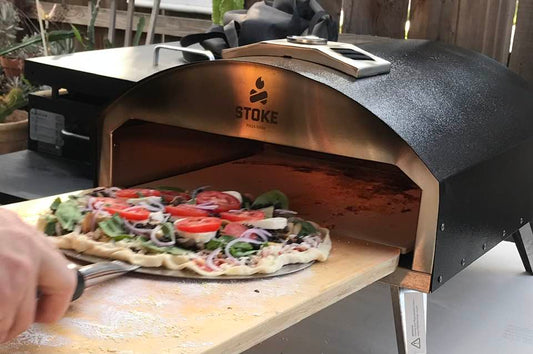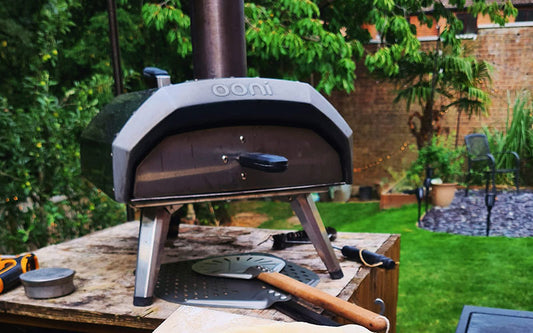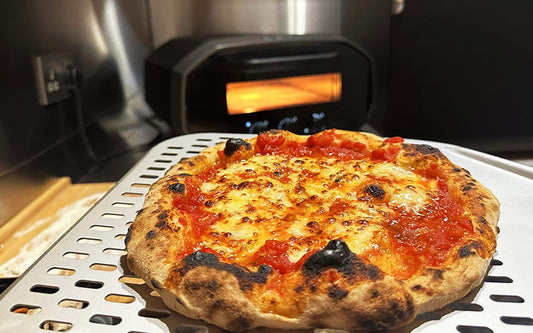If you’re an avid pizza maker, then you’ve probably experienced the frustrating moment when you go to transfer your beautiful pie from the peel to the hot oven, only to have it get stuck and end up a mess on the floor. But why does this happen?
There are a few possible reasons why your pizza dough might be sticking to the peel. It could be that your dough is too wet or that you haven’t used enough flour when rolling it out. Sometimes, it’s the temperature difference between the dough and the peel that forms condensation, which turns the flour into an adhesive. Inadequate dusting on the pizza peel or using the wrong kind of peel can also cause your pizza to stick.
Dusting the peel liberally with cornmeal, flour, or semolina will almost always do the trick. But that doesn’t resolve the problem, don’t worry. It’s not the end of the road.
In this article, I will talk about all the possible reasons why you might be having a hard time releasing the pizza from the peel. I will also give you a few tips on how to avoid this problem in the future. Keep reading.
7 Common Reasons Why Your Pizza Dough Is Sticking to the Peel
Making pizza from scratch can be very rewarding, but if you have just started your baking journey, you might run into a few issues – the most annoying of them being pizza dough sticking to the peel. Let’s look at some of the most common reasons why your pizza dough is glued to the peel:
| Reason for Sticking | Solution |
|---|---|
| Not enough flour on the peel | Sprinkle a generous amount of flour on the peel before placing the dough |
| Overworked dough | Make sure to handle the dough gently and not overwork it. |
| Too much moisture in the dough | Use the correct amount of water when making the dough. |
| Insufficient time for the dough to rest | Allow the dough to rest for a sufficient amount of time before using it. |
| Too much sauce or toppings | Use a moderate amount of sauce and toppings to prevent weighing down the dough. |
| Using the wrong type of peel | Use a peel made of wood, metal, or smooth composite material. |
1. High Hydration
High-hydration doughs are actually the gold standard of pizza doughs, but it also comes with the risk of the dough sticking to the peel. That’s because excess water can also cause the dough to spread out too much when it’s placed on the peel, making it more prone to sticking.
One possible solution to this issue is to keep the hydration level of the dough around 65% instead of 70% or higher. This means using 650 grams of water for every 1000 grams of flour. This balance allows the dough to be soft and pliable while still being firm enough to handle and transfer to the peel without sticking.
To achieve this hydration level, it’s important to carefully measure the ingredients and use the right type of flour. It’s also a good idea to let the dough rest and relax after it has been mixed and shaped, as this can help to improve the texture and make it easier to work with.
2. Wrong Choice of Flour
It’s no secret that not all flours are made equal. Flours with higher gluten content have a higher water absorption capacity. Hence, they are less likely to stick to the peel. However, too much gluten can make the dough difficult to stretch and the resulting crust too dense.
So, for pizzas in particular, choose Tipo 00 flour with 11-12% gluten content. It’s a finely milled flour made from durum wheat and combined with the right amount of hydration, it can produce a soft and pliable dough that won’t adhere to the peel.
3. Wrong Peel Material
Sometimes, the devil is in the peel. Pizza peel surface materials are commonly made of wood and metal. While both types have their pros and cons, in my experience, the chances of dough sticking to the peel is considerably less with wooden peels.
This is because wood has a rough, porous surface that helps to prevent the dough from sticking. When you’re working with a high-hydration dough, this can be especially helpful as these types of doughs are more prone to sticking.
Wooden peels are also great for stretching and rolling out the dough. The rough surface of the wood helps to grip the dough and prevents it from slipping around, making it easier to shape and transfer to the peel.
On the other hand, metal peels can be more slippery and smooth, which can make them more prone to causing the dough to stick.
4. Humidity
Humidity in the air is simply another source of hydration for your dough. Essentially, humidity is a measure of how much water is in the air, and it affects how much moisture your dough will absorb when you’re mixing it.
The more humid the environment is, the more hydrated your dough will be. While this isn’t necessarily good or bad, it can make your dough tacky and difficult to release into the oven.
5. Condensation
If none of the above factors are at play, but the dough is still refusing to slide off the peel, it may be due to condensation. Condensation is when water droplets form on the surface of your dough onto your peel.
It usually happens because of the temperature difference between the dough and the peel. Rolling out a fridge-cold dough on a room-temperature peel will guarantee that you’ll get condensation.
But, but, but, what if both your dough is at room temperature already? Well, in that case, it’s happening because the peel is too hot for the dough. If you have a brick oven or a portable outdoor oven like Ooni, you will need to rotate the pizza in the oven once or twice to ensure even browning.
The heat from the oven would make the peel hot, causing condensation when you place the subsequent batch of dough on it.
The easiest solution to this problem is using two peels – a wooden one for prepping and launching the dough and a metal one for rotating and removing the baked pie from the oven.
6. Lack of Dusting
Another common cause of pizza dough sticking to the peel is a lack of dusting. Dusting refers to the practice of sprinkling flour, cornmeal, or semolina onto the surface of the peel before placing the dough on it. This helps to create a barrier between the dough and the peel, preventing the dough from sticking to the peel as it’s transferred to the oven.
If you don’t use enough dusting, or if you skip this step altogether, the dough is more likely to stick to the peel. This can be especially problematic if you’re using a smooth, non-porous material like metal, as these types of peels tend to be more slippery and can cause the dough to slide around or stick more easily.
The type of dusting you use is a matter of personal preference, but it’s important to use enough to create a noticeable layer on the surface of the peel.
Besides using a sufficient amount of dusting, make sure that the dusting is evenly distributed across the surface of the peel. If the dusting is clumped or unevenly applied, it can create areas of the peel that are too dry or too wet, which can cause the dough to stick in those areas.
To ensure even coverage, shake the peel gently or use a small brush to spread out the dusting evenly.
7. Under-kneading the Dough
Under-kneading the pizza dough can also cause it to stick to the peel. Kneading the dough helps to develop the gluten, which gives the dough its elasticity and structure. If the dough is not kneaded enough, it can become weak and fragile, making it more prone to sticking to the peel.
There are a few key signs that your dough may not have been kneaded enough. One, the dough is too sticky or soft when you’re trying to work with it. This can make it difficult to shape and transfer to the peel without it sticking or falling apart.
Two, the dough does not hold its shape well and tends to shrink or collapse when you try to stretch it out.
To prevent these issues, it’s important to make sure that you knead the dough enough to develop the gluten. The exact amount of kneading required will depend on the type of flour you’re using and the humidity levels in your working environment.
In general, it’s a good idea to knead the dough for at least 5-10 minutes by hand or until it becomes smooth and elastic. If you’re using a mixer, you may be able to get away with a shorter kneading time.
What to Use for Dusting Pizza Peel to Prevent the Dough From Sticking? Top Suggestions
Flour
The OG and omnipresent dusting flour for pizza peels – regular flour hardly ever disappoints. Just make sure not to overdo it, or it will give your pizza a floury taste.
Cornmeal
One of the most popular choices for dusting pizza peels, cornmeal will prevent your dough from sticking and make it easy to slide off the peel onto the hot stone. It has a slightly coarser texture than flour and a subtle nutty flavor too. I personally love the rustic look and taste it gives to my pizza.
Cornmeal is also a great option if you’re looking for a less messy alternative to flour, as it doesn’t tend to fly around while you’re transferring your pizza onto the peel.
Semolina
Some folks find the grittiness and flavor of cornmeal on the baked crust rather off-putting. If you can relate to that, try using semolina instead. It has a finer texture and a more subtle flavor compared to cornmeal.
I love how it crisps up the bottom of the crust while leaving the top nice and chewy. If you’re looking for something that will give your pizza a more traditional Neapolitan style, this is probably your best bet.
Polenta
Some pizza chefs argue that polenta results in an even crunchier crust than semolina and cornmeal. It also has a stronger corn flavor that many people enjoy. I personally prefer semolina or cornmeal, but if you want something different and want to try polenta out, give it a shot by all means.
Tried and Tested Tips for Preventing the Pizza Dough From Sticking to the Peel
- Make sure to generously and evenly dust the peel with plain flour or even better, something coarser in texture, like semolina or cornmeal.
- If you are confused between metal and wooden peel, I’d suggest going with a wooden peel because it’s a porous surface. This simply means better air circulation beneath the dough, hence lesser chances of sticking to the peel surface.
- Allow the dough to come to room temperature before rolling it out to prevent condensation.
- If you are using a brick oven, invest in two peels. One for prepping the pizza (preferably wooden) and another for moving the pie around in the oven (preferably metal). This will ensure that one of the peels is always at room temperature. It’s another key step in preventing condensation.
- Knead the dough long enough. Do a poke test to check if the dough has been kneaded long enough. Simply poke the dough and see if the indentation goes away quickly. If it doesn’t, keep kneading.
The windowpane test is another good indicator of whether the dough is done. You can do this by stretching the dough and holding it up to the light. If you can see through it without tearing, then it’s ready for rising.
If it’s already too late for the precautions, try your best to release the dough from the peel using a small spatula. Be very gentle while doing this, or the dough will come apart.
Related FAQs
How do you lubricate a pizza peel?
Use semolina, cornmeal, or flour to prevent the dough from sticking to your pizza peel.
Which is better, a wood pizza peel or metal?
In general, well-dusted wooden pizza peels are better for rolling out, dressing the dough, and launching the pizza into the oven.
On the other hand, a metal peel, being a better conductor of heat, is ideal for rotating the pie around and retrieving the pizza from the oven. If you are using a regular oven, go for a wooden peel.
Should you oil a wooden pizza peel?
A lot of brands suggest coating their wooden peel with mineral oil to prevent cracking.
Conclusion
I know nobody likes a sticky mess, but with pizza dough, it’s a problem we all have to deal with. The good news is that you can avoid it by following these simple tips and tricks. And you’ll be left with a clean peel, perfect pizza, and a happy stomach! That’s all for today.
If you have any secret hack of your own to keep pizza dough from sticking to the peel, let me know in the comments below.




